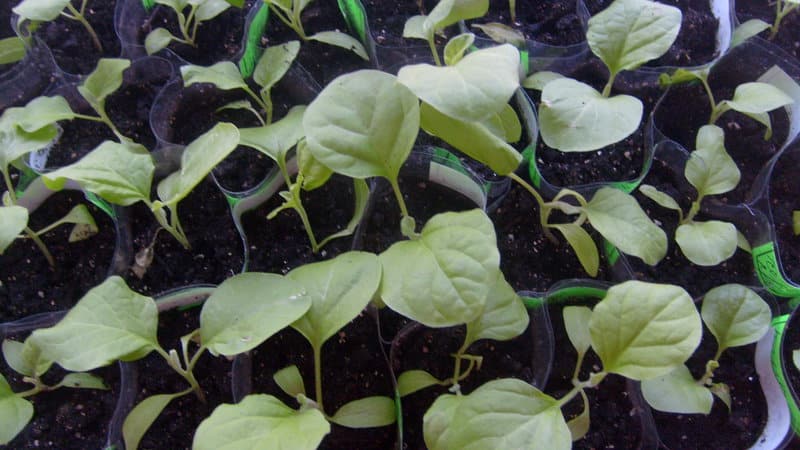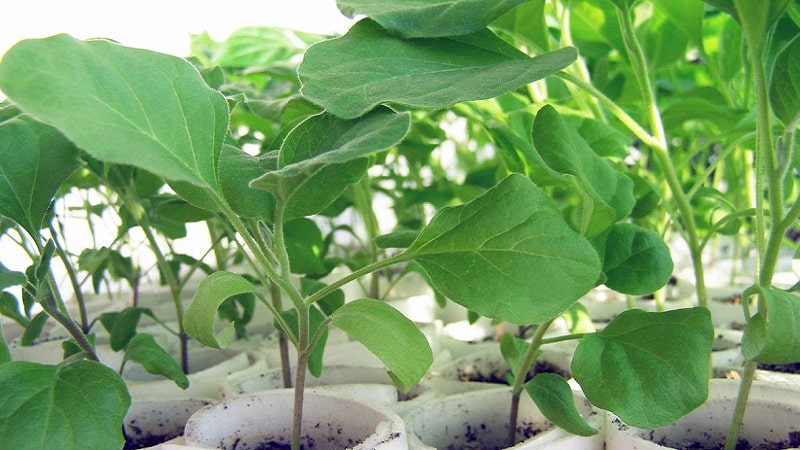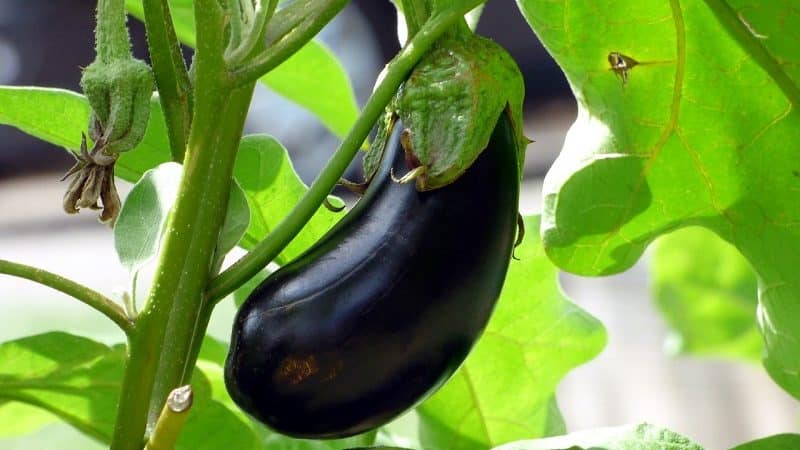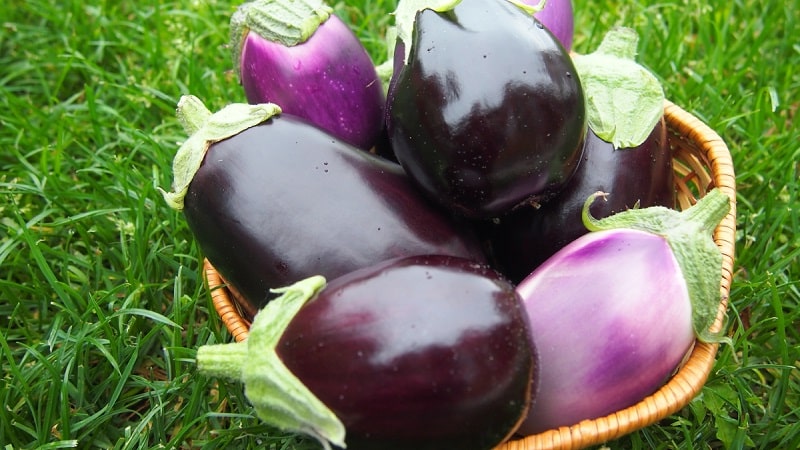Instructions for growing eggplants from A to Z
Eggplants are a favorite product of many housewives. They are nutritious, healthy, good for preparing hot dishes and pickling for the winter. The question of how to grow eggplants is relevant for many gardeners.
The culture is very capricious and is sensitive to negative environmental factors. To get a good harvest in the climatic conditions of our country, you need to follow the rules of agricultural technology and take into account a number of nuances. Read on to learn about growing eggplants from A to Z.
Growing seedlings

Growing seedlings is an important stage in eggplant cultivation. The endurance of adult plants and their productivity depend on how high-quality the seedlings turn out.
The timing of sowing seeds differs in different regions:
- in cities with a southern climate - the end of February;
- in the central regions - the first half of March;
- northern - late March or early April.
Plants are planted in open ground 2.5 months after sowing the seeds. By this time the soil should warm up to +20°C.
Important! Experienced gardeners say that it is better to sow seeds late than to do it too early. After all, if by the time the plants are planted in open ground, inflorescences appear on them or the stems have time to stretch, they will take root much longer and will produce a harvest later.
Selection of seed
High-quality planting material is the key to a good harvest and strong, viable plants. The list provides some tips for choosing eggplant seeds:
- High-yielding varieties are demanding on soil composition and difficult to care for. For the first time, it is better to choose less demanding crops that produce a small amount of fruit. For beginning gardeners, these varieties will be more productive.
- Immunity. Eggplants that are resistant to infections are preferable. It is especially important to have resistance to viral pathogens that cannot be treated or prevented.
- Resistance to temperature changes. This parameter is especially important for the northern and central regions. Such varieties have a less delicate taste, but are distinguished by simple agricultural technology.
- Hybrid seeds often have more uniform fruits and high resistance to unfavorable environmental factors. Seeds from their harvest do not retain hybrid characteristics and are not suitable for cultivation. Therefore, if you plan to harvest seeds from fruits, choose varietal plants.
- Each variety or hybrid is intended for cultivation in a specific climatic zone. Use planting material designed for growing in a specific area.
- Better germination will be achieved by seeds that are disinfected and covered with a nutrient coating. in factory conditions.
There are many varieties available at gardening markets. Examples of the most unpretentious:
- Bibo;
- King of the North;
- Vakula.
Preparing seeds for planting

Before sowing the planting material, it is prepared. This is especially important for those seeds that have not been processed in the factory. This procedure reduces the likelihood of plant infection, accelerates the appearance of first shoots and increases their resistance to negative environmental factors:
- Warming up the planting material. It is enough to place the package with seeds 2 weeks before sowing near the battery. This stimulates the emergence of seedlings.
- Checking seeds for germination. They are soaked in a glass of water with the addition of 1 tsp. salt. Planting material that has sunk to the bottom is considered suitable for planting.
- Disinfection of planting material. For this purpose, the seeds are soaked for 20 minutes in home remedies (light pink solution of potassium permanganate or hydrogen peroxide) and in store-bought preparations (Fitosporin) according to the instructions.
- Growth stimulation. This procedure will increase the germination of seeds, accelerate their germination and improve resistance to temperature changes. As home remedies, use aloe juice, honey water (1 tsp per 1 tbsp. water), soda solution (1 tsp. per 1 tbsp. water). Special drugs are sold in stores (Epin, Kornevin).
Some gardeners additionally germinate seeds before sowing. To do this, they are placed in a warm place, first wrapped in a damp cloth for 3-4 days. This step is optional.
A few words about containers and soil
Eggplants need a nutritious, light soil mixture with neutral acidity. This soil can be purchased at the store (universal mixture for seedlings) or prepared independently.
Option for preparing nutrient soil:
- garden soil, humus and sand in a ratio of 2:2:1;
- peat, river sand and compost - 2:1:1;
- humus, garden soil, rotted manure, sawdust - 3:3:1:1.
After preparation, the soil is disinfected. To do this, it is calcined for half an hour in the oven or in a water bath. Another option is to water the soil with a dark pink solution of potassium permanganate.
Add 1 tbsp to a bucket of treated soil mixture. ash and 0.5 tbsp. potassium sulfate.The soil is left in a warm place for 2 weeks so that beneficial microorganisms can form in it.
Eggplants do not tolerate picking well. Their seeds are sown immediately in individual containers. It is better if these are peat pots or tablets, from which you do not need to remove the plants when transplanting them to a permanent place.
Plastic pots, cassettes and containers made from scrap materials are also used. It is treated with a dark pink solution of potassium permanganate. It is important that there are drainage holes in the bottom.
Advice! To reduce the likelihood of blackleg development, it is recommended to pour disinfected drainage, such as coarse sand, into the bottom of the seedling containers.
Growing seedlings at home

2-3 eggplant seeds are sown in each pot, deepening them 1 cm. The soil is moistened with a spray bottle. Some gardeners place a layer of snow on the ground instead. It is believed that this additionally hardens the seeds, making the seedlings more resilient.
Containers with seedlings are covered with film and placed in a place with a temperature of +27...+30°C. At this stage, plants do not need light or oxygen. The film is removed as soon as the first shoots appear.
In order for the seedlings to be strong, it is important to provide them with regular care. The list contains the basic rules for growing seedlings:
- As soon as the first shoots appear, the film is removed. The seedlings are moved to the windowsill. If the seeds were sown in February, they will need illumination with phytolamps or fluorescent lamps 12 hours a day. The lighting device is placed at a distance of 50 cm from the pots with plants.
- To ensure that the plants are strong and do not stretch out ahead of time, they are provided with a special temperature regime.For the first week after emergence, the seedlings are kept at a temperature of +16...+17 °C during the day, then they are moved to a room with a temperature of 23–27 °C. At night, throughout the growing period, the temperature is reduced to 15°C.
- Eggplants are afraid of drafts. Throughout the entire period of growing seedlings, it is important to avoid exposure to this negative factor.
- Eggplants don't dive. They are immediately seated in individual pots.
- Water the seedlings as the top layer of soil dries. Plants are sprayed with a spray bottle, always with warm water.
- Eggplants are fed 2 times during the entire growing period. The first is 2 weeks after germination. Use fertilizers with a high phosphorus content. Purchased preparations are suitable, for example, “Crystalon yellow” (1 tbsp per 1 bucket of water) or homemade remedies (herbal infusion with the addition of 20 g of superphosphate per 1 bucket of water). Next time, fertilizing is applied 5 days before planting in a permanent place. The same professional preparations or homemade products with added potassium will do.
- 2 weeks before planting the plants in a permanent place, they begin to harden. To do this, place eggplants on the balcony, on the street or in a greenhouse for several hours every day, gradually increasing the hardening time.
Advice! Some gardeners believe that if sufficiently nutritious soil was used for seedlings, then it is not necessary to feed it.
Landing at a permanent place
Eggplants are planted in a permanent place 2-2.5 months after sowing the seeds. By this time, the soil at a depth of 15 cm should warm up to +15...+20 °C.
Seedlings are not only grown independently, but also purchased on the market. Here are some signs of quality young plants:
- Greens should not be limp. The leaves are bright green.
- The height of the plants varies between 15–25 cm. Each eggplant should have at least 5 and no more than 7 leaves.
- Early varieties may have 1-2 flower buds. Seedlings of late varieties of eggplant should not have flowers.
Advice! Experienced gardeners advise removing inflorescences from seedlings before planting them in a permanent place.
Soil preparation
To grow eggplants in open ground or in a greenhouse, it is important to prepare the soil and choose a location in advance. This is a demanding soil composition and heat-loving crop.
The most illuminated area of the garden is prepared for planting. Nightshade crops should not grow on it for the past 2 seasons. The best predecessors for eggplants are any greens and melons.
Potatoes and tomatoes should not be planted next to eggplants. They attract pests and illnesses.
The beds begin to be prepared in the fall. They are dug up and cleared of plant debris. For each square meter, add 6 kg of humus or rotted manure, 1 kg of ash. If the soil is heavy, then add river sand. All fertilizers are mixed by repeated digging.
In spring, the soil is leveled with a rake and cleared of weeds. For every 1 m², add 30 g of ammonium nitrate and potassium sulfate, 30 g of superphosphate and 4 g of magnesium sulfate. All fertilizers are mixed with soil.
When growing beds in open ground watered hot solution of copper sulfate prepared from 10 liters of water and 1 tbsp. l vitriol. In the greenhouse, not only the ground is disinfected, but also the walls, ceiling and floor of the room.
Planting in open ground
5 days before planting in open ground, seedlings are fed.1 day before this procedure, the soil is moistened abundantly. This will make it easier to remove the plants from the pots.
The planting pattern depends on the type of eggplant. As a rule, 3 to 5 plants are placed per 1 m². The distance between the rows is 60–80 cm. The holes are dug to a depth that matches the height of the cup in which the seedlings were grown. The width of the recess should be 20–25 cm.
A handful of ash or granular fertilizer is poured into the bottom of each hole. When planting plants, the root collar is usually not buried. This procedure will only be needed if the seedlings are elongated.
After picking, the plants are watered with warm water, spending 1 liter on each of them (the next watering is possible no earlier than after 2 weeks). Then, for the next 2 weeks, they are covered with film at night and during cold spells.
Advice! To help the plants take root, they are watered with water with the addition of Epin.
Growing and care in open ground

Eggplants are a capricious crop. To get a high-quality harvest, it is important to properly care for the plants.
The list contains the main subtleties and nuances:
- Eggplants should not be watered for the first 2 weeks after planting. To help them take root faster, the beds are regularly loosened to a depth of 5-8 cm. They are also sprayed with a weak solution prepared from 10 liters of water and 1 tsp. urea.
- It is recommended to mulch eggplant beds with grass, straw or compost. This layer will protect the roots of plants from pests and cold weather, and it will also slow down the evaporation of moisture and the growth of weeds.
- Eggplants are watered with warm water at sunset. If the beds are covered with mulch, then this is done once a week. Otherwise, the soil is moistened every other day. It should not be flooded, otherwise the roots will rot and the plants will die.
- After each watering and rainfall, the soil is loosened. During this procedure, the beds must be cleared of weeds.
- If roots appear on the roots of the eggplants, they are covered with earth (hilled up). If there is no such sign, it is not necessary to do so.
- Eggplants do not like overheating, but do not tolerate windy weather and drafts. In the greenhouse, the plants are regularly ventilated by opening the windows on only one side. In open ground in windy weather, spandbon (polypropylene) is used to cover the plantings on the windy side. To do this, install arcs or vertical structures on the beds.
- The formation of eggplants depends on the variety. Low-growing varieties do not take stepson. Tall varieties are formed into 3 stems, the remaining shoots are pinched. The leaves at the bottom of the bush are removed.
- On each inflorescence, leave 1 of the largest and most beautiful flowers. This technology will increase the yield and size of the fruit.
- Tall and medium-growing varieties need a garter. They are attached to a trellis or wooden support with synthetic thread. The growing point is pinched when the plant reaches its maximum support height.
- Feed eggplants every 2 weeks. To do this, use chicken manure diluted 1:1 with water, silage (a quarter bucket of grass is filled with ¾ bucket of water, add 1 kg of chicken manure and leave for a week in a warm place) or purchased fertilizers.
Protection from diseases and pests
The higher the variety's resistance to disease, the easier it is to grow. If the chosen crop does not have such an advantage, it is important to know the main signs of the most common diseases and methods of combating them:
- Late blight. Fruits and green plants become covered with brown and brown spots.There is no cure for the disease: damaged bushes will have to be removed and burned. To prevent planting, spray it weekly with copper sulfate or Bordeaux mixture at sunset.
- Mosaic. The leaves are covered bright green spots, and the fruits are yellow formations. There is no treatment. Affected bushes are removed, and healthy ones are treated with Fitosporin.
- Gray rot. Plants become covered with dark spots and a gray coating. Treating the soil and plants with fungicides will help save the plantings. An important part of preventing this disease is avoiding waterlogging of the soil.
- White rot. Plants are covered with a white coating. The damaged parts are cut off and these places are treated with wood ash.
- Black bacterial spot. Plants become covered with black spots with yellow borders. Affected eggplants are removed and burned. The soil and healthy plants are treated with copper sulfate.
To prevent the development of dangerous diseases, it is important to follow the rules of disinfection, crop rotation, watering and pinching. Diseases are often carried by insects, and they also damage the eggplant bushes themselves.

Common pests include:
- Spider mite. Plants are covered with thin cobwebs and small insects. To combat the pest, prepare a remedy by mixing 0.5 kg of chopped dandelions, garlic and onions in a bucket of water. The composition is allowed to infuse for 3 hours. After this, the product is filtered and a piece of crushed laundry soap is added to it. The bushes are sprayed with the drug.
- Whitefly. Large white insects appear on plants. They are washed off with water or collected by hand. As a preventive measure, yellow traps greased with a sticky mass (honey, Vaseline) are installed between the rows.
- Aphid. The bushes are covered with small midges.To get rid of the pest, the bushes are sprayed with a decoction of wormwood.
Harvest and storage

Harvest time depends on the ripening period of the variety. The ripeness of the fruit will be indicated by its large size and glossy rind with a uniform color.
Eggplants are cut together with the stalk. Store in a dark, dry place, regularly sorting the fruits. In such conditions, many varieties will last up to 2 months.
Advice from experienced agronomists

To make it easier to grow eggplants, experienced farmers use several tricks. Here are the most important secrets of agricultural technology:
- Warm beds. In such structures, plants will be protected from the cold and provided with nutrients. To do this, in the fall, dig a deep trench or build a structure in the form of a wooden box right on the surface of the soil. Wood, paper, food waste and weeds are laid out in layers into the resulting depression. Everything is sprinkled with earth on top. In the spring, this place will provide a warm nutrient substrate into which the plants are planted. One such bed lasts for 3 years.
- To get the maximum eggplant yield, it is recommended to replace the greenhouse with a film structure without a roof. In this way, all cultural requirements will be met.
- It is recommended to plant calendula between the beds, rye, basil or tobacco. They will repel harmful insects.
Read also:
How to freeze fresh eggplants for the winter at home, and what to cook from them.
Cooking eggplants like mushrooms for the winter: recipes that guests will definitely ask for.
Conclusion
Eggplant is a demanding crop with which novice gardeners often have difficulties.It is important to follow all the basic rules of agricultural technology and regularly inspect plants for diseases.
Those who grow eggplants for the first time should take a closer look at less productive but more hardy varieties. If you follow the advice of experienced agronomists, eggplants will yield a good harvest and will “forgive” minor mistakes in agricultural technology.